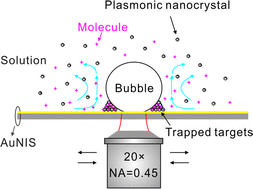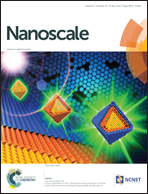Surface-enhanced Raman scattering via entrapment of colloidal plasmonic nanocrystals by laser generated microbubbles on random gold nano-islands
Abstract
Surface-enhanced Raman scattering (SERS) typically requires hot-spots generated in nano-fabricated plasmonic structures. Here we report a highly versatile approach based on the use of random gold nano-island substrates (AuNIS). Hot spots are produced through the entrapment of colloidal plasmonic nano-crystals at the interface between AuNIS and a microbubble, which is generated from the localized plasmonic absorption of a focused laser beam. The entrapment strength is strongly dependent on the shape of the microbubble, which is in turn affected by the surface wetting characteristics of the AuNIS with respect to the solvent composition. The laser power intensity required to trigger microbubble-induced SERS is as low as 200 μW μm−2. Experimental results indicate that the SERS limit of detection (LOD) for molecules of 4-MBA (with –SH bonds) is 10−12 M, R6G or RhB (without –SH bonds) is 10−7 M. The proposed strategy has potential applications in low-cost lab-on-chip devices for the label-free detection of chemical and biological molecules.


 Please wait while we load your content...
Please wait while we load your content...